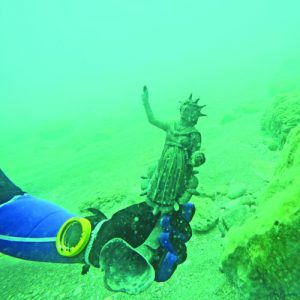×


We have detected your country as:
Please click here to go to the USA website or select another country from the dropdown list.
 Two divers at the ancient port of Caesarea discovered the spectacular cargo of a merchant ship that sank during the Late Roman period some 1,600 years ago. A joint dive at the site with Israel Antiquities Authority (IAA) archaeologists revealed the remains of a ship on the sea bottom: iron anchors, wooden anchors, and items that were used in the construction and running of the sailing vessel.
Two divers at the ancient port of Caesarea discovered the spectacular cargo of a merchant ship that sank during the Late Roman period some 1,600 years ago. A joint dive at the site with Israel Antiquities Authority (IAA) archaeologists revealed the remains of a ship on the sea bottom: iron anchors, wooden anchors, and items that were used in the construction and running of the sailing vessel.
Many of the artifacts are bronze and in a surprising state of preservation: a bronze lamp depicting the sun god Sol, a figurine of the moon goddess Luna, fragments of three life-size bronze cast statues and a bronze faucet in the form of a wild boar with a swan on its head. In addition, fragments of large jars used for carrying drinking water for the crew were found. Two metallic lumps composed of thousands of coins weighing some twenty kilograms (44 lbs.) were also discovered, in the form of the pottery vessel in which they were originally transported. The coins bear the image of the emperor Constantine who ruled the Western Roman Empire (AD 312–324), and of Licinius, emperor of the Eastern Roman Empire until he was defeated in battle by Constantine.
According to directors of the Marine Archaeology Unit of the IAA, “The location and distribution of the ancient finds on the seabed indicate that a large merchant ship…encountered a storm at the entrance to the harbor and drifted until it smashed into the seawall and the rocks.”
Archaeologists stress, “A marine assemblage such as this has not been found in Israel in the past thirty years. Metal statues are rare archaeological finds because they were always melted down and recycled in antiquity. When we find bronze artifacts it usually occurs at sea. Because these statues were wrecked together with the ship, they sank in the water and were thus ‘saved’ from the recycling process…The sand protected the statues; consequently they are in an amazing state of preservation—as though they were cast yesterday rather than 1,600 years ago.”
Source: Excerpts of an article by Edgar Asher, Ashernet
Photo Credit: Ashernet and IAA
All logos and trademarks in this site are property of their respective owner. All other materials are property of Bridges for Peace. Copyright © 2024.
Website Site Design by J-Town Internet Services Ltd. - Based in Jerusalem and Serving the World.